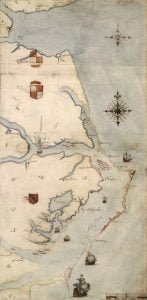Two Massacres at Matanzas
Survivors of Jean Ribault’s fleet staggered onto the beach south of St. Augustine with nothing but their torn clothes. Eventually, the castaways clustered into two groups. One, numbering about a hundred were under the command of Ribault. A smaller group came together on a beach farther south. Neither group had food or water. Apparently, none knew how to catch fish in tidal pools or which coastal plants were edible. Ribault’s party staggered northward in search of potable water. Eventually, the desperate men encountered a small search party dispatched by Menéndez to look for survivors of the French fleet. Ribault assumed … Read more


